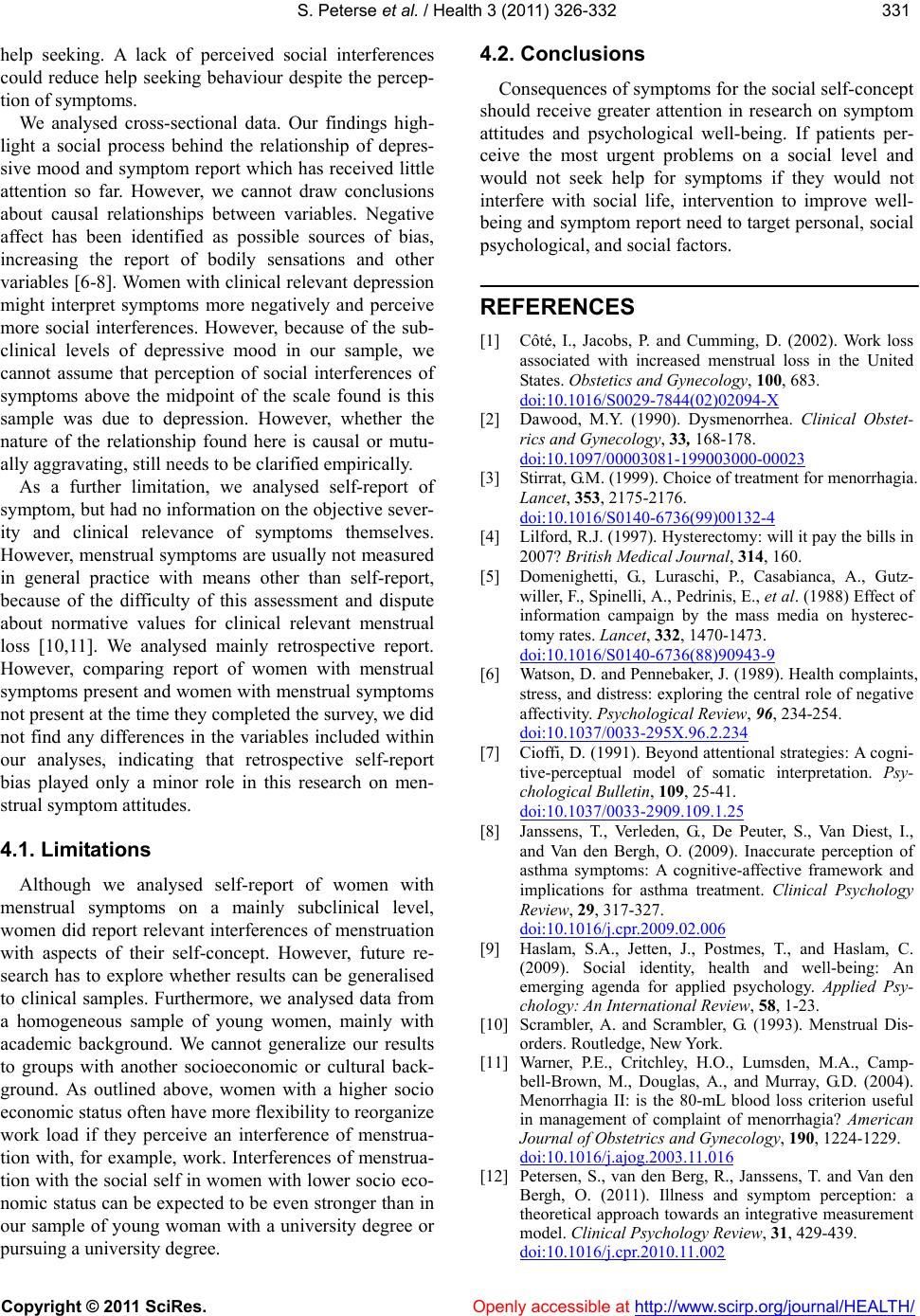
S. Peterse et al. / Health 3 (2011) 326-332
Copyright © 2011 SciRes. Openly accessible at http://www.scirp.org/journal/HEALTH/
331331
help seeking. A lack of perceived social interferences
could reduce help seeking behaviour despite the percep-
tion of symptoms.
We analysed cross-sectional data. Our findings high-
light a social process behind the relationship of depres-
sive mood and symptom report which has received little
attention so far. However, we cannot draw conclusions
about causal relationships between variables. Negative
affect has been identified as possible sources of bias,
increasing the report of bodily sensations and other
variables [6-8]. Women with clinical relevant depression
might interpret symptoms more negatively and perceive
more social interferences. However, because of the sub-
clinical levels of depressive mood in our sample, we
cannot assume that perception of social interferences of
symptoms above the midpoint of the scale found is this
sample was due to depression. However, whether the
nature of the relationship found here is causal or mutu-
ally aggravating, still needs to be clarified empirically.
As a further limitation, we analysed self-report of
symptom, but had no information on the objective sever-
ity and clinical relevance of symptoms themselves.
However, menstrual symptoms are usually not measured
in general practice with means other than self-report,
because of the difficulty of this assessment and dispute
about normative values for clinical relevant menstrual
loss [10,11]. We analysed mainly retrospective report.
However, comparing report of women with menstrual
symptoms present and women with menstrual symptoms
not present at the time they completed the survey, we did
not find any differences in the variables included within
our analyses, indicating that retrospective self-report
bias played only a minor role in this research on men-
strual symptom attitudes.
4.1. Limitations
Although we analysed self-report of women with
menstrual symptoms on a mainly subclinical level,
women did report relevant interferences of menstruation
with aspects of their self-concept. However, future re-
search has to explore whether results can be generalised
to clinical samples. Furthermore, we analysed data from
a homogeneous sample of young women, mainly with
academic background. We cannot generalize our results
to groups with another socioeconomic or cultural back-
ground. As outlined above, women with a higher socio
economic status often have more flexibility to reorganize
work load if they perceive an interference of menstrua-
tion with, for example, work. Interferences of menstrua-
tion with the social self in women with lower socio eco-
nomic status can be expected to be even stronger than in
our sample of young woman with a university degree or
pursuing a university degree.
4.2. Conclusions
Consequences of symptoms for the social self-concept
should receive greater attention in research on symptom
attitudes and psychological well-being. If patients per-
ceive the most urgent problems on a social level and
would not seek help for symptoms if they would not
interfere with social life, intervention to improve well-
being and symptom report need to target personal, social
psychological, and social factors.
REFERENCES
[1] Côté, I., Jacobs, P. and Cumming, D. (2002). Work loss
associated with increased menstrual loss in the United
States. Obstetics and Gynecology, 100, 683.
doi:10.1016/S0029-7844(02)02094-X
[2] Dawood, M.Y. (1990). Dysmenorrhea. Clinical Obstet-
rics and Gynecology, 33, 168-178.
doi:10.1097/00003081-199003000-00023
[3] Stirrat, G.M. (1999). Choice of treatment for menorrhagia.
Lancet, 353, 2175-2176.
doi:10.1016/S0140-6736(99)00132-4
[4] Lilford, R.J. (1997). Hysterectomy: will it pay the bills in
2007? British Medical Journal, 314, 160.
[5] Domenighetti, G., Luraschi, P., Casabianca, A., Gutz-
willer, F., Spinelli, A., Pedrinis, E., et al. (1988) Effect of
information campaign by the mass media on hysterec-
tomy rates. Lancet, 332, 1470-1473.
doi:10.1016/S0140-6736(88)90943-9
[6] Watson, D. and Pennebaker, J. (1989). Health complaints,
stress, and distress: exploring the central role of negative
affectivity. Psychological Review, 96, 234-254.
doi:10.1037/0033-295X.96.2.234
[7] Cioffi, D. (1991). Beyond attentional strategies: A cogni-
tive-perceptual model of somatic interpretation. Psy-
chological Bulleti n , 109, 25-41.
doi:10.1037/0033-2909.109.1.25
[8] Janssens, T., Verleden, G., De Peuter, S., Van Diest, I.,
and Van den Bergh, O. (2009). Inaccurate perception of
asthma symptoms: A cognitive-affective framework and
implications for asthma treatment. Clinical Psychology
Review, 29, 317-327.
doi:10.1016/j.cpr.2009.02.006
[9] Haslam, S.A., Jetten, J., Postmes, T., and Haslam, C.
(2009). Social identity, health and well-being: An
emerging agenda for applied psychology. Applied Psy-
chology: An International Review, 58, 1-23.
[10] Scrambler, A. and Scrambler, G. (1993). Menstrual Dis-
orders. Routledge, New York.
[11] Warner, P.E., Critchley, H.O., Lumsden, M.A., Camp-
bell-Brown, M., Douglas, A., and Murray, G.D. (2004).
Menorrhagia II: is the 80-mL blood loss criterion useful
in management of complaint of menorrhagia? American
Journal of Obstetrics and Gynecology, 190, 1224-1229.
doi:10.1016/j.ajog.2003.11.016
[12] Petersen, S., van den Berg, R., Janssens, T. and Van den
Bergh, O. (2011). Illness and symptom perception: a
theoretical approach towards an integrative measurement
model. Clinical Ps ycholo gy Review, 31, 429-439.
doi:10.1016/j.cpr.2010.11.002